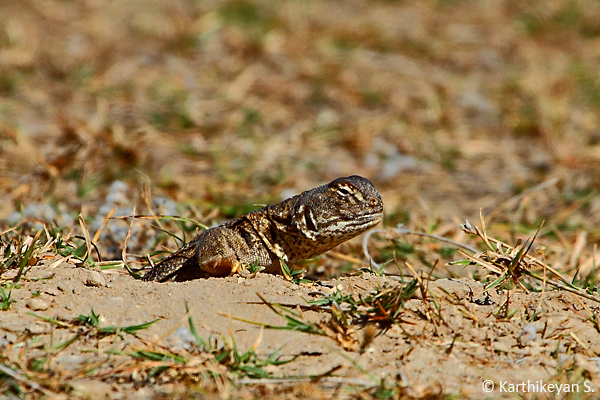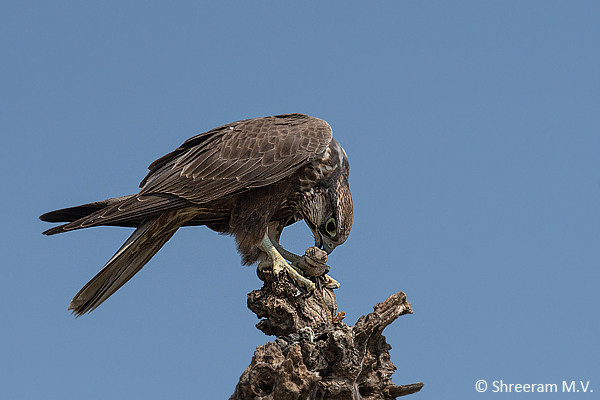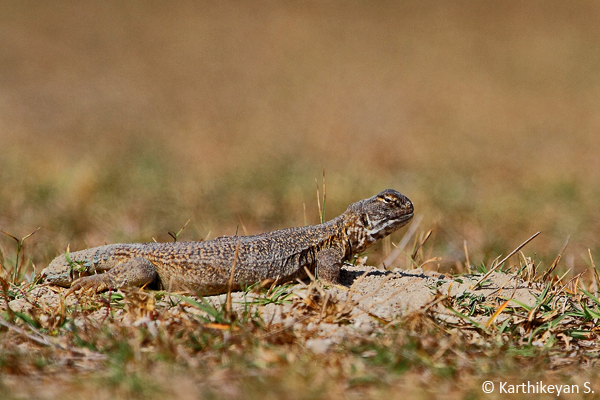As I walked out of the premises of the bus stand of a small sleepy town in Karnataka, my attention was drawn to a loose congregation of about a dozen people on the side of a narrow road that normally had few people. They were all standing around a person sitting on his haunches. I stood across the road with my backpack strapped firmly to my back trying to make sense of what was transpiring. Once I was convinced that there was no argument or violence, curiosity got the better of me. I crossed the road to see what the people were up to. I noticed that the man sitting on the ground had a tarpaulin spread out in front of him. On it were some lizards – about 6 small lizards (different looking with a large head and a tail covered in spines) and 2 large lizards with long tails. I recognized the large lizards as Monitor Lizards.
These motionless lizards were the wares he was trying to sell to the crowd that also seemed as inquisitive as I was. He spoke about the fat in the tail of these lizards and the medicinal uses of the same.
Something seemed amiss to me. The fact that none of the lizards, though alive, was trying to run away. They just lay still. I noticed that there was something common to all these motionless lizards – they all had a swelling on their back. This was very strange and piqued my interest.
I was forced to leave the location as I had a bus to catch. If I missed the bus, I would have to wait a whole day to reach my destination! Yes, those were days when transport to some remote wilderness areas (not so remote any more) was scarce, telephone connectivity non-existent and most of the places of stay had no power! For a youngster (that I was then), all this uncertainty added to the sense of adventure.
Upon arrival at the camp, I was quick to narrate this story to my senior colleague. He confirmed the identity of the bigger of the lizards. The smaller ones, based on my description, he identified as the Spiny-tailed Lizard. He went on to say that they are found in arid areas of the northwestern parts of the country and that they were called ‘sanda’ in Rajasthan where they commonly occur. Also, that they used their spiny tails for protection. Now that was interesting indeed.
When asked about the lump on their back, I was told that it was due to a broken spine! That explained why the lizards, though alive, were unable to move. This, I thought, was very cruel. I also learnt that hawking these lizards was illegal.
Looking back some 35 odd years ago, what I witnessed was to remain in my mind and perhaps will remain for more time to come.
Now, let us come back to the Spiny-tailed Lizard. That day was the first time I had heard the name of this lizard. I would recollect the lizard story only during the several slide shows on reptiles that my colleague and I would conduct. I would promptly forget all about it until the next event.
Finally, a plan to visit the arid regions of the country with a few friends fell into place and I reached Jaipur during the second half of November 2013. I was very keen on experiencing this habitat and the denizens thereof first hand. The Spiny-tailed Lizard Saara hardwickii was certainly on the to-see list, besides a few other faunal species. I spent a large part of the visit looking at birds of this habitat. A plethora of raptors – falcons, eagles, harriers, vultures and other hawks – kept us occupied as did a range of other birds – Stolickzas Bushchat, Water Pipit, and Spotted Creeper to mention a few.
In one area, my attention was drawn to several mounds of pale mud. On closer examination, I noticed a small burrow near each of these mounds- handiwork of the Spiny-tailed Lizards. The area was also crisscrossed with several footpaths that were used by two wheelers too.
I kept watch over one of the burrows that was close to where we were. After a few minutes of wait, I noticed a small movement and a grey-coloured head popped out, scanning the surroundings. I quickly took a few pictures. I was hoping that the lizard would come out completely so that I could see the spiny tail.

A Spiny-tailed Lizard that has tentatively come out from the burrow.
Even after waiting for a considerable amount of time, nothing much changed. Therefore, I planned to come to the same area early the following morning, wait for the lizards to come out to bask in the warmth of the sun and perhaps also see them go about feeding.
Incidentally, these are the only Indian lizards to have a largely herbivorous diet. This also makes them an important part of the ecosystem as both resident and migratory raptors are known to feed on the Spiny-tailed lizards to a large extent.

A Laggar Falcon feeding on a Spiny-tailed Lizard.
The next morning, braving the cold, I executed the plan. I lay flat on my belly not far from two burrows and hoped that at least one would pay off. I chose a spot under the shade of a tree as I knew that I would get very hot as the day progressed. My friends who also wanted to try photographing the lizard took positions near mounds that were within earshot of where I was. The ploy worked. Even as the day warmed, the lizards started surfacing, ever so cautious. Eventually, one individual that I was watching came out fully and settled right next to the burrow. I could get a good view of the entire lizard, not to mention a few pictures as well.

A Spiny-tailed Lizard basks next to the burrow. As can be seen, the habitat that it uses it very flat with sparse vegetation. The soil is hard and not sandy. Ample ground vegetation is also present.
At this juncture, something unexpected happened. Two people on a motorbike drove very close to where I was lying and stopped. They were curious about my strange behavior of lying down flat on the ground. The spiny tails feeling threatened, retracted into their burrows. Realizing that any further possibility of photographing this lizard was wrecked by curious bystanders I stood up and cursed loudly in Kannada to my friends that our chances were ruined. They too had a disappointed look on their faces at the sudden turn of events as all the lizards nearby went in to their burrows.
We started walking towards our vehicle that was parked at a distance when the bikers approached us and asked in Kannada – ‘Sir, are you from Karnataka?’ I sheepishly smiled (for I knew that they understood what I had just said!). We indulged in a petty conversation for a bit, exchanging pleasantries. They soon left and we all burst out laughing. Who would have expected to bump into a fellow native so far away and in this manner?
However, when we were driving out at the end of the trip, we noticed another individual well away from a burrow and not far from the road. We slowed down and picked up our cameras that were kept handy and got some more pictures of this lizard. And those were the best photographs that we managed of the very interesting Spiny-tailed Lizard.

A Spiny-tailed Lizard with the full compliment of the spines visiible.